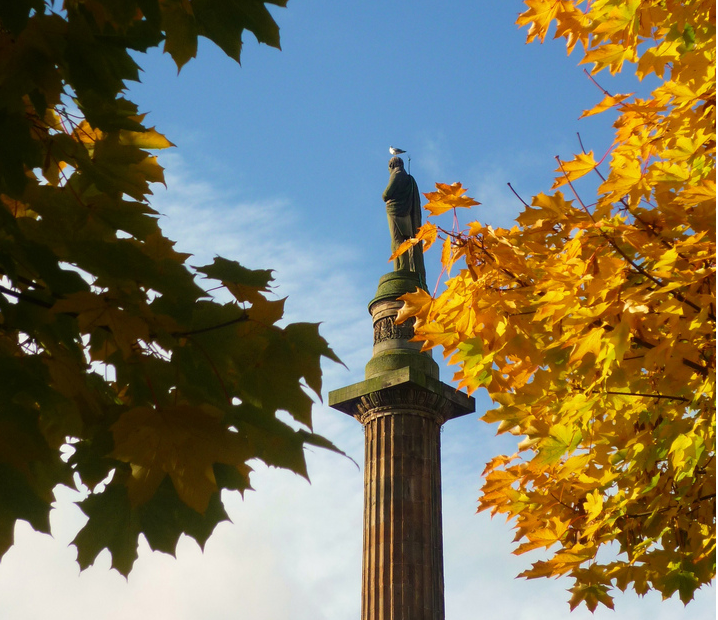All day I have watched the purple vine leaves
Fall into the water.
And now in the moonlight they still fall,
But each leaf is fringed with silver.
Amy Lowell
Autumn is a second spring when every leaf is a flower.
Albert Camus
There’s something inspiring about autumn. But even if we’re not poets, the city dwellers among us can appreciate the vibrant hues of amber and burgundy as urban trees put on their annual colourfest.
The visual appeal of trees speaks for itself, but the trees in our city streets, parks and gardens also make year-round contributions to our environment:
- Absorbing rainwater and assisting storm water management
- Filtering the air we breathe
- Providing habitats and food for wildlife
- Shading and cooling
- Masking noise
- Promoting a general sense of wellbeing
Many of the trees in our major cities were planted in Victorian times, and since then significant numbers have been devastated by the effects of climate change, pests and disease. In the 1970s, Dutch elm disease killed an estimated 25 million elm trees in the UK. More recently, scientists have forecast that a deadly fungus could kill up to three quarters of the UK’s ash trees within the next four years. The impact of ash dieback may be widespread. Nick Johannsen, director of the Kent Downs Area of Outstanding Natural Beauty (75% of Kent’s ash trees are expected to be affected) told The Guardian:
“Our landscapes and townscapes will diminish and our wildlife will suffer, there will be a very real economic cost in making roads, railways and urban areas safe as trees succumb to primary and secondary infections over time.”
But the fight to keep trees in Britain’s cities has already begun. In 2010, the Forestry Commission launched its Big Tree Plant campaign to increase the number of trees planted in towns, cities and neighbourhoods throughout England. So far, over 800,000 have been planted, and the campaign is on course to plant its millionth tree by the end of the initiative in 2015.
In addition, public and private sector bodies have been collaborating with communities to find inventive ways of bringing new trees into Britain’s cities, and to raise awareness of their impact:
- The Royal Botanic Garden Edinburgh has been working with the city council to introduce unusual and endangered species to parks and gardens. Among the recent additions to Princes Street Gardens are six Serbian spruce saplings from samples brought to Scotland 20 years ago during the turmoil of war in Yugoslavia.
- In Manchester, the Green Streets project has accompanied newly-planted trees with plaques explaining the environmental and social benefits of tree-lined streets.
- In London, a green infrastructure audit commissioned by the Victoria Business Improvement District (BID) resulted in new plantings, along with “green roofs”, “green walls” and rain gardens as part of a wider green infrastructure strategy.
Welcome as these initiatives are, they may not be enough to protect and rejuvenate the UK’s urban treescapes. The Big Tree Plant campaign will end next year, and there are concerns that funding for future initiatives will not be forthcoming.
Trees for Cities, an independent charity which encourages urban tree planting, has called for a comprehensive national survey of tree cover and a long-term strategy to re-green urban communities. Trees for Cities has also suggested that money raised by local authorities from the Community Infrastructure Levy could be directed to planting trees.
Some of the positive aspects of trees are hard to quantify in financial terms. In 2005, the Forestry Commission’s Nature’s Health Service report claimed that trees promote physical activity, ease stress and anxiety, and instil a sense of local pride. While this may be true, local authorities facing budget pressures may need more tangible evidence to make a case for funding further planting.
However, as the concerns surrounding ash dieback indicate, the cost of not planting, protecting and maintaining urban trees may be far higher than investing in green infrastructure. One of the startling findings from the Victoria BID green audit revealed that existing trees, green spaces and other green assets hold up and divert more than 112,000 cubic metres of storm water run-off away from the water network annually. This amounts to £49,000 of savings in pumping, treatment and carbon costs.
Which may not be very poetic, but it’s another reminder of how trees are quietly enriching our quality of life.
Further reading
The Idox Information Service has a wealth of research reports, articles and case studies on a range of environmental issues. Items we’ve recently summarised for our database include:
Our green cities (trees in urban areas), IN Tree News, No 27 Autumn/Winter 2014, pp14-17
Greening London (green urban infrastructure), IN ENDS Report, No 472 Jun 2014, pp42-43
Trees in hard landscapes: a guide for delivery
The root of a successful city, IN Sustain, Nov/Dec 2013, pp35-37
N.B. Abstracts and full text access to subscription journal articles are only available to members of the Idox Information Service.
Share
Related Posts
The Knowledge Exchange Information Service will close on Friday 23 December. Our service will reopen on Tuesday 3 January 2023. The first bulletin of 2023 will be published on 11 January, and the first Topic Updates of the New Year ....
It is well recognised that the UK faces a shortage in STEM (science, technology, engineering and maths) skills, and that at current projections, this gap in skills and knowledge is only going to grow in the coming years. Before the ....


